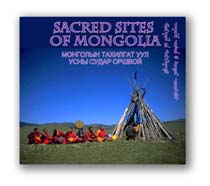Sacred Mongolian Environmental Texts
 |
 |
 |
This collection of ancient sutras, Sacred Sites of Mongolia, translated into modern Mongolian by Dr Hatgin Sukhbaatar, is the first of a planned series. |
Mongolian nomads have a long tradition of honouring the land through religious books, praying in order to try and avoid natural disasters such as drought and heavy snowfall. Here is a prayer asking for blessings from the Deity of the Blue Sky:
Dear Blue Eternal Heaven
Let summer come to us
Let well-being come to us
Let winter go away
Let rain come to us
Let wind go away
Let it be wet
Let us have more grassland
Traditionally Mongolians believe the deity of Heaven is male, while Earth is female: heaven bringing nature to life, and land shaping and sustaining it. The fate of humans is interwoven with the fate of nature.
Mountain-sutras are a repository of ecological and religious wisdom – the earliest manifestos for environmental protection. They were derived from Mongolian culture but written in Tibetan, the religious language of Mongolian Buddhism. This is the first time they have been translated into modern Mongolian, making them available to a wide audience of Mongolian believers.
Often the mountain is named after its deity. A sutra from snowy Kalkh says:
Welcome to the land where sun and moon are identical.
The deity of the mountain is Dartsagt, who rides a great horse.
Most mountain sutras honour the deities of the mountains and waters, wishing to prevent disaster, and praying for a good harvest and the increase of sacred animals like the snow leopard – ‘let there be as many as there are stars in the sky.’
The sense of disaster can be very real – many believe the mountain deities are responsible for droughts and snow storms, and punish those who do not respect them.
The people around Mt Ulaankhairkhan revere a female deity who lives on their mountain in the form of a roebuck. One day, a story goes, she was killed by a hunter who did not recognise her. The hunter fell seriously ill soon afterwards. Such taboo stories can be very important in enabling areas to become sanctuaries.
Information on this page has been adapted from the Introduction to ‘Sacred Sites in Mongolia’, written by Dr Hatgin Sukhbaatar. see Books
Pages about Mongolian Environmental Wisdom, taken from the Handbook.
The Mongolian Lord of Nature.
Sacred texts, places and ovoos.
Sacred sites
in Mongolia.
Traditional Environmental Law in Mongolia.
The work that the monks, in conjunction with ARC and the World Bank and others, are carrying out to rediscover the sutras about sacred land in Mongolia.
Do you want to support this?
For full contact and address details of Mongolian Buddhist Monasteries, please see page 57 of the
Handbook. And for details of local Development, Environmental and Educational NGOs, please visit pages 58-59 of the
Handbook.
Other links to Mongolian Buddhism and the Environment
Link here to access the news story about the launch of the Mongolian Buddhist Handbook.
Link
here to download the Mongolian Buddhist Handbook in English. (Please note this file is 1.15MB)
Link
here to download the Mongolian version of the Handbook.(A 2MB file.)
Link here to download the guide to the Mongolian Buddhists’ Eight Year Plan (this file is 4.13MB).
Link to Mongolian Case Studies.
And
here on how to make contact with the Sangha.
To download the A3 poster of a new thangka about Buddhists protecting Nature, link
here (5.61MB).
Brief History of Mongolian Buddhism.
Buddhism and the Environment.
Women in Buddhism in Mongolia.
Key Figures in Mongolian Buddhism.
Key Meetings in Mongolia.
Mongolian Buddhists and Development.
Mongolian Buddhists and Ecology.
Mongolian Buddhist Hunting Ban.
The Lost Sutras.
|

